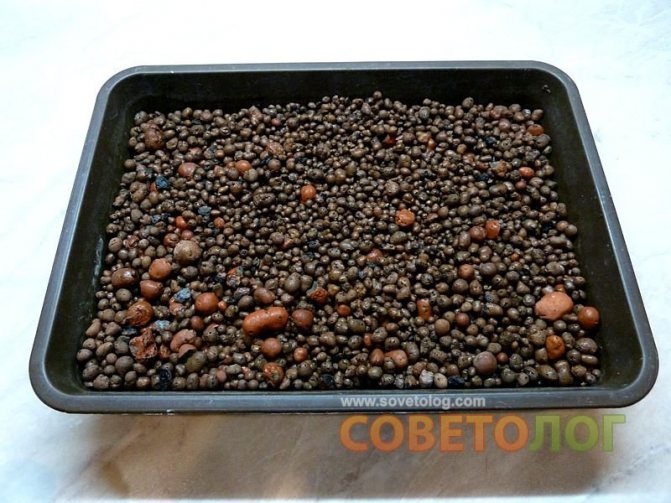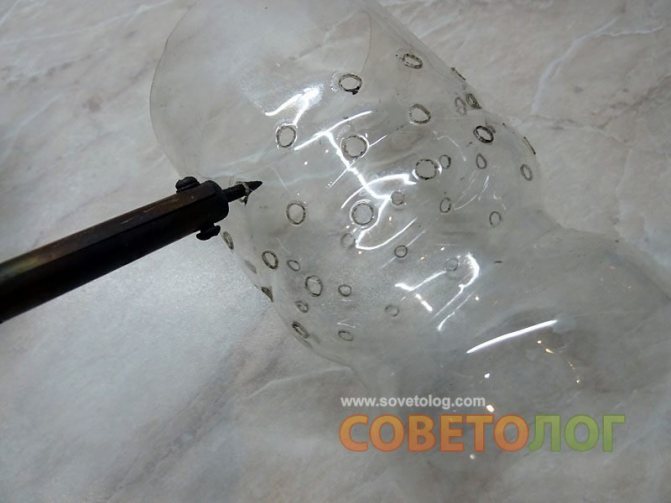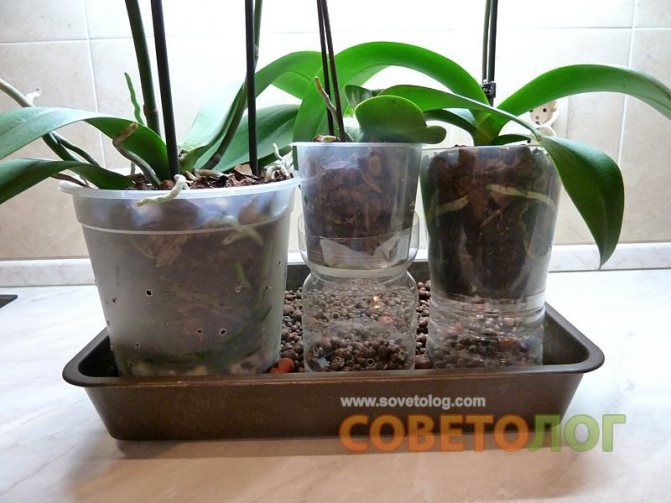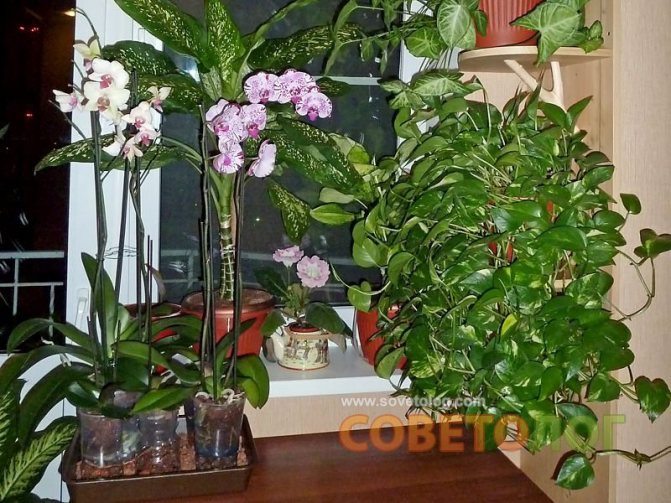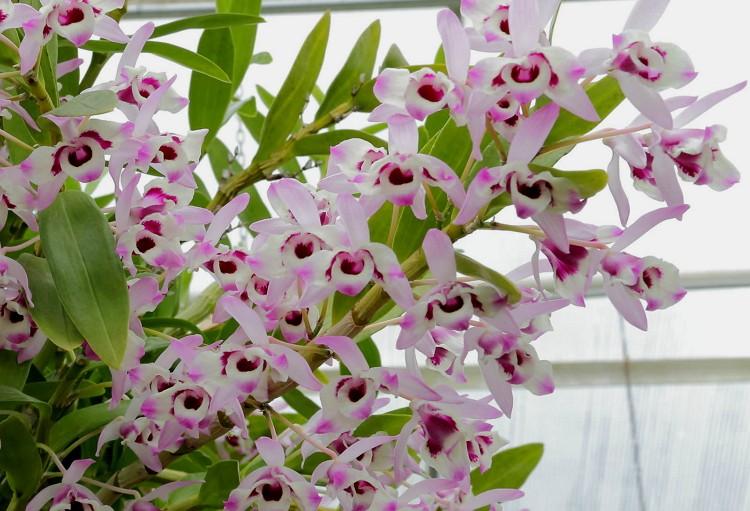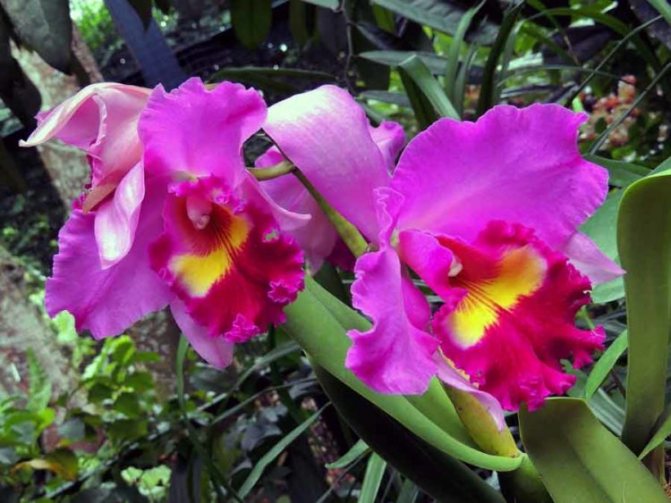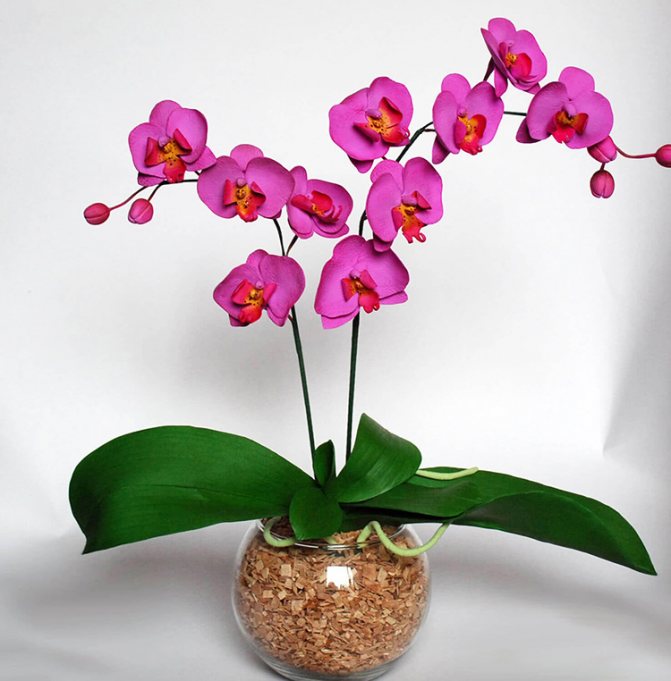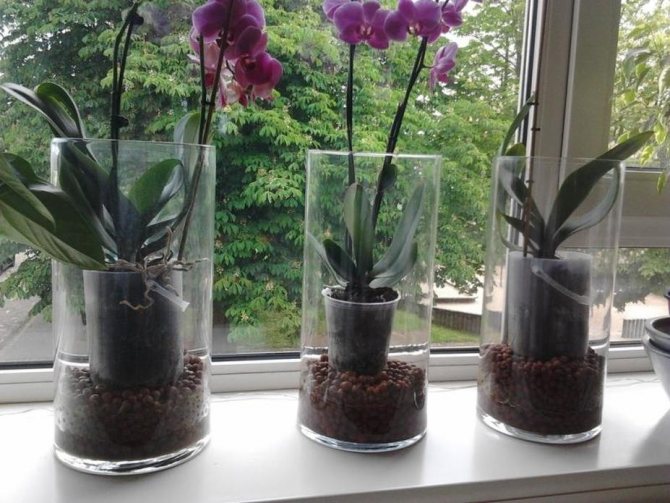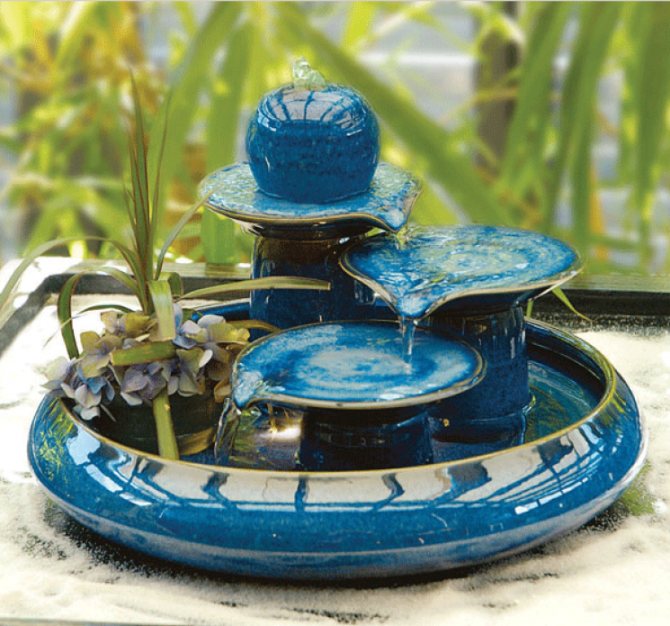Orchids, like all plants, are temperature dependent creatures. Therefore, the correctly selected mode and temperature range of the content is an:
- The key to successful cultivation;
- Orchid health;
- And its lush flowering.
Deviation from the norm, in turn, may have opposite effects... Let's find out what temperature is needed for orchids.
Lighting for orchids at home in summer. Watering
The need for life-giving moisture is different for all orchids. Some can stay in completely dry ground for several days without problems. For example, Cattleya and Dendrobium just need to "dry out" from one watering to another. And the phalaenopsis in the pot should always be slightly damp. But just "a little bit", since the stagnation of moisture for its root system is destructive.
Nearly all orchids would rather be in a dry environment than in a damp environment. In a critical case, they will calmly survive a week or two without watering. If they are "drowned" in water for the same two weeks, the plants will not survive this.
In summer, for orchids, the most optimal watering regime will be 1 time in 3-4 days. In winter, the intervals between watering can be increased to 7-10 days.
Orchids are watered differently from all other houseplants. If you just pour water into the pot from above, then the flower will not receive the amount of moisture it needs. It is better if the lower part of the substrate in the pot is moistened - the orchid itself will draw out as much liquid from it as it needs. Pour some room temperature water into the basin (be sure to settle or filtered) - so that the depth is only 1-2 cm. Put the pot with the orchid there. Through the drainage holes in the bottom of the pot, water is absorbed into the substrate. Keep the pot with the plant in water for no more than 10 minutes - this time is quite enough for optimal moisture of the substrate. The excess water will flow out on its own into the saucer or tray on which you usually have a flower pot.
The phase of active growth, the formation of buds and the flowering itself are the reason to water the orchids more intensively. When a plant has a dormant period, its need for watering is reduced.
Possible mistakes
There are three main mistakes associated with the choice of lighting:
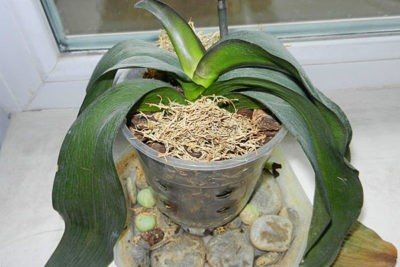
Lack of light... At the same time, the leaves become dark green, sometimes even with a blue tint, become lethargic and die with a prolonged lack of light.- Excess light can cause overheating, and even death of the plant, since it cannot process more light than it needs. In this case, the leaves usually take on a reddish tint.
- Wrong choice of light... An excess of blue light, with a lack of red, will cause vigorous growth of leaves and shoots, but such an orchid will never bloom. The opposite situation can provoke abundant flowering, while an insufficiently formed thin peduncle may not withstand the weight of the flowers and break, and the leaves will develop unevenly.
Orchids are delicate flowers and are completely unsuitable for our climate, they need warmth, regular watering and irrigation, as well as enough light, and then they will be able to regularly delight their owners with bright exotic flowers.
How to light up orchids in winter. What is it for?
First, let's decide why plants need light. Photosynthesis takes place inside the green leaves of an orchid, carried out by a green pigment - chlorophyll. It absorbs blue and red light from the solar spectrum using chlorophyll A and B.
Chlorophyll B absorbs sunlight - long red waves at 642 nm. and short blue at 453 nm. Chlorophyll A is involved in the processing of energy received at long red waves at 662 nm. and short blues from 410 to 430 nm. Light absorption is not uniform throughout the day - blue light is absorbed almost all day, and red light is absorbed in the morning and evening. In winter or in a poorly lit apartment, it is almost impossible to achieve this kind of lighting. Therefore, lamps are a must for orchids grown at home.
Important! When choosing a lamp for an orchid, make sure that there is both blue and red light in it.
Red helps flowering, and blue helps to build up deciduous mass, but only combined lighting will lead to the harmonious development of the flower. We will talk in more detail about what phytolamps are needed for orchids and how to choose them in the corresponding section.
There are also some rules for proper lighting of the phalaenopsis orchid. In general, phalaenopsis is not very whimsical to lighting, but in order for the orchid to develop correctly, it is best to create conditions with bright diffused light, that is, place it in partial shade. For this, it is better to place the plant on the western or northeastern windowsill. If you put your flower in direct sunlight, then you risk burning the leaves of the phalaenopsis, which appear as brown spots and depressions on the leaves. Natural sunlight is not necessary for the flower, it can also be illuminated piece by piece.
In winter, the flower needs at least 12 hours of lighting, in summer it must, on the contrary, be protected from excess light, because later, the leaves of the orchid will be small, and the winter lack of light will become even more painful. In the autumn, when the flower begins to bloom, the plant must be supplemented so as not to risk new buds, which can dry out with a lack of light.
When caring for a home phalaenopsis orchid, it is also important to know that over time, the flower leans towards the light source, which leads to its gradual curvature. To avoid the irregular shape and structure of your orchid, it can be rotated 180 degrees every 2-3 weeks. The only time when it is forbidden to do this is the period of bud formation.
Another lighting tip. If you are not sure about the lighting level of an orchid, just place your hand between the phalaenopsis and the light source. If the shadow from the hand is not clear, there is just enough light, but if the contour of the shadow is easily distinguished and clearly outlined, this indicates that the light is too bright and you better find another place for your phalaenopsis.
The orchid is a very capricious plant, each gardener chooses whether to start acquaintance with her or not.
The orchid needs special care
... How to care for tropical flowers in our climate?
The health and growth of this exotic light-loving plant primarily depends on whether it is correctly lit.
Constant flowering is possible with sufficient and correct lighting.
... Does an orchid need light? If the leaves are pale, lethargic or yellow, then it's time to organize the backlight.
If additional light sources in the form of lamps are not provided in winter, then the orchid will simply retire. In winter, some flowers may stop growing altogether until spring, while others develop very slowly. That is, at home, a tropical plant has a forced dormant period (for details on what should be the conditions for keeping an orchid, read).
Which type to choose: LED, fluorescent or other?
Consider which lamp is best for illuminating the plant. The first thing to remember when choosing a lamp: in no case should it heat up. Ideally, the light source should not emit heat at all, as even a small amount of it can negatively affect the plants.
For breeding orchids, the following types of lamps are used:
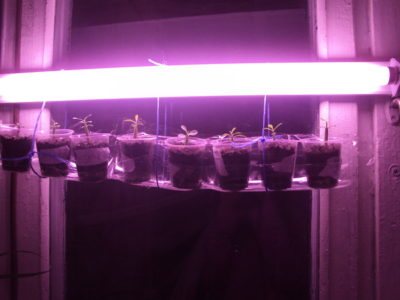

energy saving;- luminescent;
- metal halide or gas discharge;
- mercury gas discharge;
- LED (or LED).
All these options are suitable for organizing additional illumination of plants, but fluorescent and light-emitting diode (LED) lamps are considered the most optimal for floriculture, it is on their basis that most special phytolamps are produced. Such lamps do not produce heat at all and at the same time emit light waves of the required intensity and length.
Red or blue?
As stated earlier, for growth and development, orchids need rays of red and blue light... Red light contributes to the abundance and duration of flowering, blue - affects the formation of leaves and shoots, therefore their balanced combination is important, otherwise the plant either simply does not bloom or may undergo serious deformations.
For the correct additional illumination, you must choose either two lamps of different colors, if necessary supplementing them with an ordinary daylight paw, or purchase a combined lamp, which already contains both elements.
Is the plant light-loving or shade-loving?
An orchid can bloom constantly if there is enough light.
, but its lack leads to stretching of the leaves and pseudobulbs, the leaves brighten. A tropical flower, up to a certain point, is able to protect itself from excess sunlight. But too bright light will lead to damage. Lack of lighting will slow down or stop flowering growth.
Which option do you prefer?
To the question of how much and what kind of light an orchid needs, the answer is unambiguous - a lot, but at the same time it is very afraid of direct sunlight. Therefore, in the summer, the houseplant must be shaded to avoid burns, and in the cold season, when additional light is needed,.
Temperature conditions
Minimum
It depends on which particular plant you are talking about. If we take the thermophilic Phalaenopsis, then 15 ° C is critical for it, which, in principle, is the norm for the same Rossioglossum that hibernates in this state.
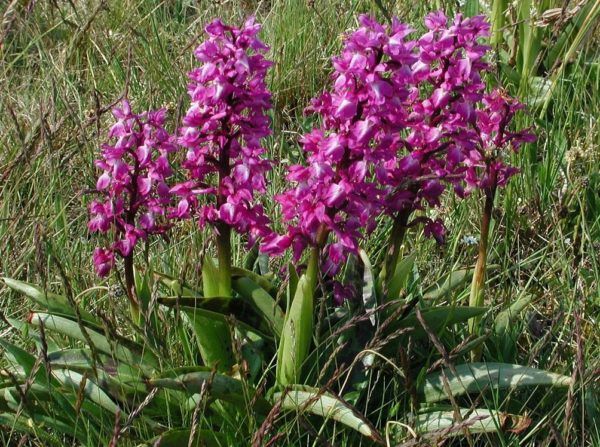

Orchis can be found in Russia, as it tolerates frost well.
Orchis or Lyubki - orchids of the middle band they completely hibernate under the snow, withstanding freezing temperatures and severe frosts.
Roughly speaking, it is better not to check home orchids for wear and not to lower the temperature below 12 ° C, even for cold-loving species. An inept decrease in temperature in the moist state of the plant and the soil in which it is located, may cause:
- Stress;
- Reset colors;
- General loss of decorativeness;
- Frostbite;
- Disease;
- Or even the death of the plant.
Maximum
The maximum, as well as the minimum, are relative concepts. The maximum for thermophilic orchids, which is not accompanied by a shock state, is 28 ° C. For a short time, 30 ° C is also possible.
In nature, high temperatures are leveled other natural phenomena, for example, by wind or rain, which cool the plant itself.
Effect on plant growth
Negative.It is known that the maximum intensity of the photosynthesis process is observed at t = 25 ° C. Deviations from this value reduce intensity, respectively, inhibit the activity, growth and development of the entire plant.
How to understand that your beauty is uncomfortable precisely from the high temperature of the content? Orchid shows it with all its appearance:
- Elongated shoots;
- Withering;
- Loss of leaf turgor and pseudobulbs;
- Discharge of flowers or their rapid wilting;
- Sunburn is also possible on the leaves;
- Withering and dropping of the lower layer of leaves.
Diseases
High temperatures alone do not cause disease. They can only cause loss of decorativeness of the plant.


A spider mite appears on an orchid when high temperature is combined with humid air.
However, in combination with other factors, for example, dry air - the appearance of pests is possible:
- Spider mite;
- Shield, etc.
BUT combined with humid, musty air and lack of ventilation:
- The appearance of mold;
- Rot, etc.
Seat selection
An ideal location for a tropical flower next to a natural light source.
The most optimal dislocation for growing an orchid is east and west windows
... There will be enough light here in the cold season, and in summer there will be no scalding sun rays.
On particularly hot days, in order to avoid burning the leaves, after lunch, the plant must be hidden, for example, behind a tulle curtain. South-facing windows are beneficial for orchids in winter and are very dangerous in summer.
Street orchids
Any type of tropical orchid can be grown outdoors, in any region where the night temperature does not drop below t = 15 ° C. Traditionally, it is customary to do this with large subtropical orchids, for example, Cymbidium or Oncidium, which can be display in large heavy pots right in the garden.
Advice! When growing orchids in your garden, keep safety in mind. It is necessary to carry out preventive insecticide treatments to reduce the likelihood of damage by harmful parasitic insects. Also, such a plant can have great material value and can simply be stolen - do not leave them unattended for a long time.
For orchids of the middle lane, the above does not apply - their can be grown directly in the ground.


Orchids such as the Lady's Slipper can be grown in the ground.
However, they often live in symbiosis with fungi (mycorrhiza) and quickly die (within 2-3 years) after transplanting from their natural habitat.
How do I darken?
Tropical plants love bright and diffused light at the same time.
... This can be done at home using a transparent fabric, such as curtains. In the spring, orchids growing on the windowsill must be shaded from the sun. It is better to move the flower at a distance of 1-1.5 meters from the window.
On the windowsill, you can shade a tropical plant with a thick sheet of paper, a mosquito net or blinds.
We suggest watching a video on how to make shading for orchids:
Questions From Readers
Do orchids like temperature changes?
They do not like him, this phenomenon is only part of their usual living conditions. Temperature difference orchids react positively, since they have it in their genes and is a signal for reproduction, that is, flowering.
What difference is acceptable?
Daily optimal is drop 5-10 ° С... The seasonal difference may be greater, especially if it is calculated for cold-loving orchid species.
What are the consequences of too low temperatures at night?
Hypothermia least, maybe:
- Reduce the activity of the entire plant;
- Induce hibernation in him.
As maximum, can cause:
- Frostbite;
- And death.
What is wrong lighting, what are the consequences?
Now that we have figured out whether a light-loving plant is an orchid or not, it is important to determine if a tropical plant is properly lit. The indicator in this case is the leaves. In a healthy orchid, they are bright green. If the leaves darken - the plant clearly does not have enough light, if they turn yellow or acquire a reddish tint - there is too much light.
Does the plant love the sun enough to feel good in direct light? No - they are the main enemy of tropical flowers and can lead to burning leaves. Windows located on the south side are especially dangerous.
... It is best to place exotic flowers on north, east and west windows.
Growing trees and opposite houses can save from the hot sun. The orchid loves the sun, but intense lighting can lead to tanning of the plant and, as a result, pigmentation, this is not scary and does not require treatment, it is enough to rearrange the flower in the shade. But the burnt leaves will not recover until they die off naturally. Lack of light also negatively affects the life of a tropical flower. Therefore, from autumn to the end of winter, it is necessary to use backlighting.
Proper lighting is of the utmost importance in orchid care.
... They require a lot of light and lack of direct sunlight. In summer, pots with exotic flowers are best kept on windows facing east and southeast, and in winter, west and southwest. If there is a lack of lighting, it is necessary to use lamps.
views
When does the need for additional light arise?
The need for additional lighting largely depends on the location of the windows - if they are on the north side or are covered by trees and other houses, indoor plants will lack sunlight almost all year round.
With other options, backlighting is still needed:
- in winter all day long;
- in autumn and spring at dusk.
Important! Weakened plants may also need additional lighting, regardless of the season.
What differences does the plant withstand?
If the difference between day and night is more than 10 degrees, then at night the plant begins to secrete a certain sticky liquid - glucose. Such an environment is favorable for the development of fungal diseases, which will negatively affect his health.
If the temperature is too high, the bulbs and leaves of the plant begin to evaporate more moisture than they can absorb. This puts him in a stressful state and plant cells begin to break down.
The consequences of such a drop have a detrimental effect on the health and overall aesthetic side of the flower.
Power and types of lamps for illumination
Experts have found that orchid lamps are simply necessary in living conditions. The calculation used data on the required amount of artificial light, its duration and intensity. Based on the results obtained, scientists have identified:
- The distance at which the lamp is set from the plant depends on the species to which this or that orchid belongs. This distance is calculated by the florist himself. For example, you should not feel heat radiation with your hand, even at a distance of 10 cm from the lighting fixture.
- These lamps must not have a heating effect. The total power of luminescent specimens should be no more than 120 watts. When choosing, you should pay attention to the marking.
- When buying, the following mistakes should be avoided: you should not give preference to an ordinary energy-saving lamp, these specimens are suitable only if your home oasis contains several types of orchids (more than ten).
Of all the variety, it is better to give preference to a specialized phytolamp, only it can reproduce high-quality lighting, which is especially necessary if you have a large collection of orchids; You should not purchase LED and fluorescent lamps if you do not have proper experience in floriculture.
Energy saving lamps cfl
Their advantage mainly lies in economy, namely:
- energy consumption is several times less with higher output;
- in the process of their use, short circuits are practically excluded, therefore such lamps are considered safer;
- have a long service life, which is confirmed by the official warranty card;
- possess both types of spectrum (red and blue).
According to manufacturers - developers, 80% of the lamp power goes to lighting plants, while the remaining 20% is taken by heat energy. It is required to place these lamps at a certain distance from the flowers (should not be less than 5 cm). Also, do not forget that during the flowering period the plant needs a warmer type of lighting, closer to yellow. As daylight, universal are suitable, and cold tones are required during the growing season.
Luminescent
Fluorescent fluorescent lamps are those specimens that contain gaseous substances, most often mercury, inside. Thanks to a coating such as a phosphor, gases are converted into ultraviolet rays. Lamps are equipped with the following markings:
- LDC (suitable for daytime, has improved color rendering);
- LB (white glow);
- LD (daylight).
For orchids, the shades 865,33,840 are most suitable.
Halogen
This lamp has a second name - gas discharge, but when illuminated, this does not affect the plants in any way. Moreover, they are quite similar to conventional incandescent bulbs, but with better lighting quality. Halogen bulbs come in a variety of colors and shapes, but specialized models should be purchased for orchids.
Mercury gas discharge
They have a similar principle of operation as fluorescent lamps. However, the labeling is different, which should be taken into account when purchasing. Orchids require lighting with a temperature of 3200 to 4200 kW. There are also lamps of this type for low and high pressure (sodium).
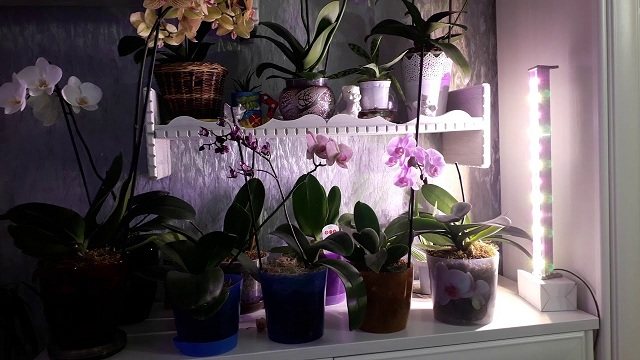

LED
These are the most popular lamps among florists. Their popularity has appeared due to environmental safety, the absence of ultraviolet radiation, efficiency, resistance to temperature fluctuations and mechanical stress. They have a long service life and high efficiency. Florists use combined copies that combine both red and blue light in one lamp, which gives high-quality diffused lighting.
Bicolor and full spectrum lamps
This type of lamp contains two types of lighting - blue and red. It is used to generate energy in the plant and starts the important process of photosynthesis. It has an optimal light wavelength and is recommended for orchids located in a lighted area, such as a windowsill or closed balcony, where there is natural sunlight. This light promotes the development of young orchids in the vegetative stage. This lamp is quite versatile, it is indispensable for orchids in winter, as well as in conditions of lack of light.
Full spectrum lamps have colors such as blue, far red, simple red and warm white in their range. The uniqueness of this lamp lies in the maximum stimulation of the natural flowering of orchids. Penetrates well through dense green leaves, is indispensable in the absence of sunlight.
We offer you to watch a video about phytolamps:
Humidity in a city apartment
The air humidity in the room is determined by a special device - a hygrometer. Although without a sensor, it is clear that in winter, in a city apartment with central heating and plastic windows, the air can be very dry. There is a direct dependence of the humidity indicator on the air temperature in the room:
| Indoor air temperature, ° C | Background moisture content,% | Humidity indicator after 4-5 hours of operation of the humidifier,% |
| +15 | 50-60 | 60-70 |
| +20 | 40-50 | 50-60 |
| +24-26 | 20-30 | 30-40 |
| +28-29 | 10-15 | 20-30 |
The desire to increase the humidity by any means, if the room is hot, to put it mildly, is not productive.It is much more expedient to optimize the temperature by adjusting the heating system (if technically possible) and organizing regular ventilation (having previously protected the plants from drafts). Alternatively, you can fence the edge of the window sill from the dry hot air of the battery with a high rim made of glass, plastic or cellophane film. Plants in such an impromptu orchidarium should be placed so that the leaves do not touch the cold glass.
The author of the book "Orchids in your home" Maria Zugurskaya.
Flower needs at different times of the year
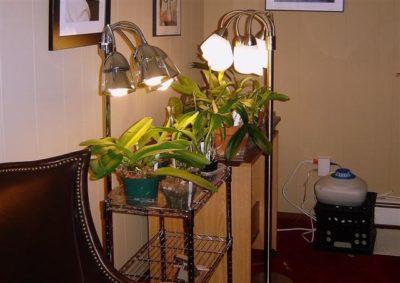

Most orchids need extra lighting from October to March., the rest of the time, natural light should be enough. If the windows are facing north, lamps may be needed from April to September.
In spring and autumn, the lamps can be turned on not for the whole day, but as additional lighting at twilight.
The total duration of daylight hours for an orchid - natural or artificial, should not be shorter than 10 hours, but also not longer than 12-14 hours.
Different types of orchids need different light intensity... You can distinguish them by the shape of the leaves. The most light-loving - with narrow, cylindrical leaves or xiphoid. Slightly less demanding - with pseudobulbs and tough, thick leathery leaves.
Medium illumination will be enough for orchids with pseudobulbs and thin leathery leaves. The least demanding plants are without pseudobulbs with wide leathery or tender and soft leaves. Orchids are flexible flowers. If there is not enough lighting, they will still bloom.
Attention! To overdo it with light is just as bad as not to light it up. The plant will not take more than it needs, and excess energy can lead to overheating and death.
For more information on how much sun and additional lighting an orchid needs at home, we suggest reading in another article.
Signs of insufficient moisture
Important! Each orchid has its own preferences regarding the microclimate. Conditions suitable for one instance may be completely unacceptable for another.
Signs that the plant is uncomfortable due to too dry air:
- the tips of the leaf plates turn yellow and dry;
- buds fall off, barely blooming;
- the break between flowering phases is delayed;
- leaves turgor decreases;
- the plant withers, despite feeding and watering.
We fertilize and feed
Florists feed the flower once every two weeks during the growing season. There are specialized fertilizers for indoor orchids. Better to read the label carefully and follow the directions. A good rule of care would be monthly flushing of the substrate with water, since as a result of fertilization, the concentration of minerals increases, the flower does not like this. During the dormant period, the plant does not need feeding.
RECOMMENDATION! (click to find out)
RECOMMENDATION! You can skip top dressing if you change the substrate once a year.
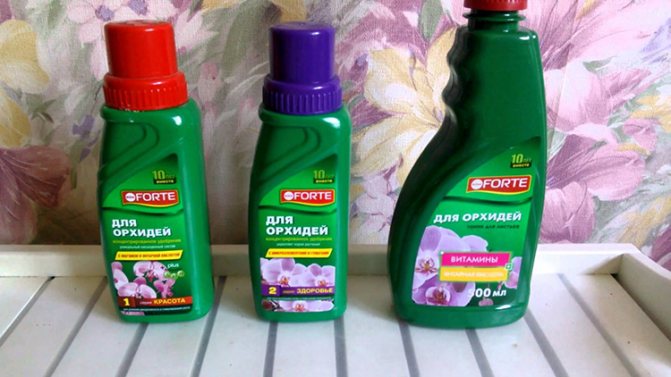

Fertilizers for orchids
Cutting off a wilted peduncle
A typical mistake of novice florists is the early removal of peduncles on orchids. If you cut off the green part of the arrow immediately after dropping the buds, the plant can throw out a new shoot. Removing the green seedling stimulates the orchid to bloom again. But a weakened plant does not have the strength to form new buds. Such a rash act of a florist can cause illness or even death of an indoor flower.
You need to cut the peduncle at the drying stage. When the shoot turns light yellow and dry, you can remove it. It is recommended to use garden shears or a sharp knife to trim the stalk. The height of the hemp should not exceed 1–2 cm. If there are dormant buds on the peduncle, the estimated place of the cut is shifted by 1.5–2 cm.


Peduncle pruning scheme after flowering
The cut site is treated with beeswax. Such measures for the care of an exotic indoor flower prevent the development of fungal and bacterial infections.
Errors and ways to eliminate them
The absence of flowering of the plant or rare flowering indicates the wrong conditions of detention. Often, beginner growers make standard mistakes. Let's consider them briefly:
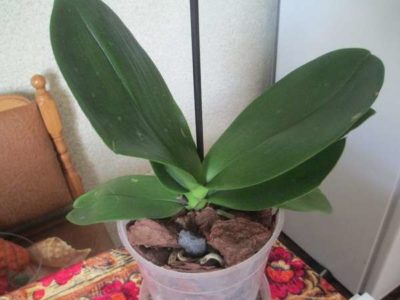

Poor light supply - the orchid is a very light-loving plant, therefore it should be provided with this necessary condition.- Non-compliance with the rest period. In winter, the orchid does not require high humidity, heat and light.
- There is a large amount of nitrogen in the added fertilizers, it must be reduced.
- Excess moisture in the root system. To do this, it is necessary to ensure the outflow of water, as mentioned earlier.
- But the lack of moisture will negatively affect the flowering of orchids.
- In addition, a plant may have various diseases, and an attack of pests is possible (it is necessary to treat the plant with special means). But this happens again due to improper care of orchids.
The consequences of a sharp change in temperature
Even for humans, a sudden change in climate entails stress. For delicate and fragile orchids, this situation becomes even more stressful. And stress affects the plant in completely different ways..
In one case, it is negative. The flower begins to weaken, hurt, or even completely: die. But it may be different. Such a change in climate can be the impetus for the awakening of the orchid. The fact is that when a flower is absolutely comfortable in the created conditions, it stops working: to grow actively, to release flower stalks with buds. But leaving your comfort zone can activate the orchid and make it fight for survival. The main thing is that such a change should be short. Usually it will take a week to wake up.
What does the quality of care affect?
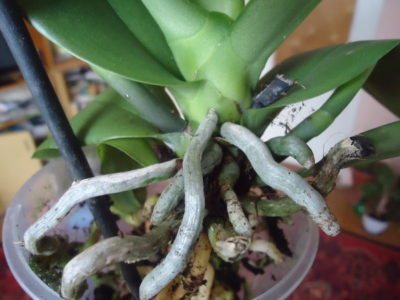

Many parts of orchids may be affected, depending on the conditions. And with proper care, they will also testify to the health of the plant.
The roots of a plant will speak of proper care if they are green (with abundant watering) or silver-gray (in orchids with dry bark) color.
Leaves should be free of plaque, punctures, mold and stains. A blooming orchid testifies to good care; with poor care, there are no flowers on the plant.
Useful Tips
Growing in full artificial light
It does not always work find a sufficiently lit place for the orchid. There are many examples of growing them completely under artificial lighting.
What is important to decide:
- Set modes day and night temperatures... They are essential for many orchids. Especially for flowering;
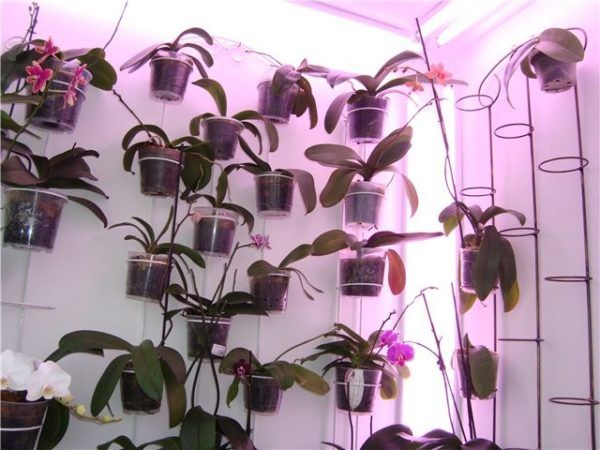

Orchid lighting option. - Provide other conditions as well for the selected type of orchid: Humidity;
- Air circulation;
- And necessarily the power of the lamp and its distance from the flowers.
Solar lamp
Here's worth see such lamps in reality... The beauty in the garden becomes special. In the evening and at night. 5 pcs for 370 UAH For the garden and home - great!
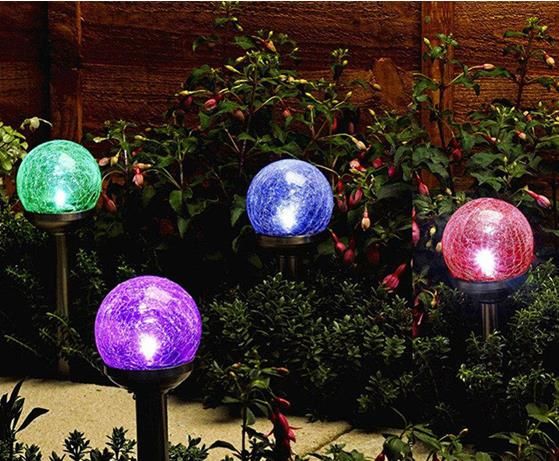

And the usefulness for orchids is a separate topic. And this is not about frugality. About usefulness... They do not provide the best growth and flowering spectra (red and blue) for orchids. And you can count.
Health
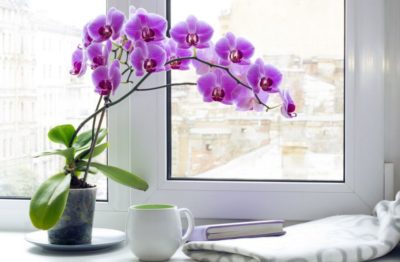

All orchids are divided into several groups, each of which requires certain temperature conditions for comfortable growth.
They are quite sensitive to temperature changes and therefore, making a mistake or not taking into account which category the flower belongs to, you can ruin it. It can also affect the health and duration of its flowering.
What temperature do orchids like? At what temperature should an orchid be kept?


Novice flower growers are often interested in what temperature is considered optimal for an orchid.It can be attributed to the category of the most capricious flowers that need anxious care. However, provided that a microclimate in the room is created that is close to natural living conditions, the flower will perfectly take root at home. One of the most important criteria for proper care is the temperature regime.
The regularity of flowering and its duration depend on the correctness of temperature fluctuations. Today, three types of orchids are known, which differ in their characteristics. For each individual species, the grower must recreate certain conditions, so you should know what air temperature is best for the orchid of different varieties.
Temperature regime
The vital activity of the flower directly depends on the correctness of the selected temperature. A plant only inside a comfortable microclimate will be able to bloom regularly and even give children. Therefore, it must be remembered that today three types of orchids can be grown at home:
- The heat-loving flowers were brought to Europe from coastal rainforests or plains. The most famous among them are phalaenopsis, dendrobiums, and also some varieties of cutleys. Plants in this category must be kept warm. In summer, the temperature should be at least +15 and not more than +32 degrees, and in winter - from +15 to +18, while the daily difference cannot exceed three to five degrees. An exquisite home orchid at an optimal temperature will hurt less;
- Medium-temperature flowers grow in the mountainous tropical zones. These varieties include odontoglossums and miltonia. Such an orchid should be kept at lower temperatures. In summer, the plant will feel best at +18 - +22 degrees, and in winter - at +12 - +15 degrees;
- The cold-loving type grows in subtropical climates or in the highlands. This includes most laelias, papiopedilums and Australian dendrobiums. The optimal regime for them in summer is from +22 and in winter from +12 degrees.


Generally speaking, we can say that the optimal temperature for an orchid of any variety is from +18 to +27 degrees during the day, and from +13 to +24 at night. If you strictly adhere to the regime and observe the necessary differences, the plant will not only bloom regularly, but also give children.
It is also important to correctly combine this principle of care with proper watering. The flower should be watered only in the morning so that the moisture has time to dry out in the evening. Until the dairy temperature drops, no water droplets should remain on the leaf, otherwise the plant will begin to rot and it will be quite difficult to save it. It is also forbidden to leave it in drafts or in direct sunlight after watering. Orchids prefer diffused abundant sunlight.
If you follow all the rules of care, closely monitor your indoor pet, you will notice that keeping it is no more difficult than any other flower from the home garden. A wild, untouched orchid survives in almost any conditions at the air temperature of its natural habitat, so the correct regime will help the plant to take root at home.
General rules for care
Orchids are very delicate flowers that require careful care... If you want your flower to grow actively, follow these rules:
- High humidity is provided in the room so that the plant does not dry out.
- Make the soil not too dense, air should flow to the roots. At the same time, the orchid does not like drafts.
- Alternate watering the plant while the substrate is completely dry.
- The room temperature should not rise above 30 ° C or fall below 10 ° C.
- Orchids love bright light, without which they cannot bloom and stop growing.
You will find all the conditions for keeping this flower in this article.


